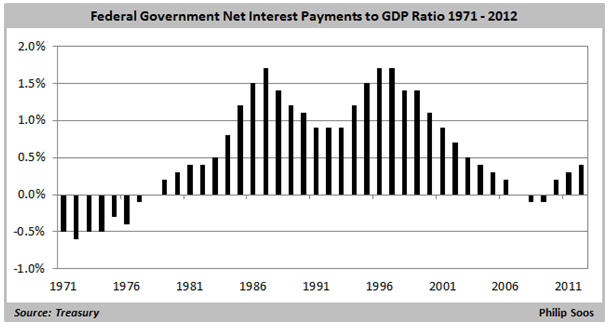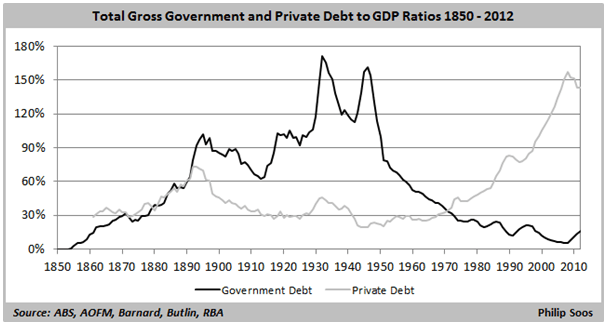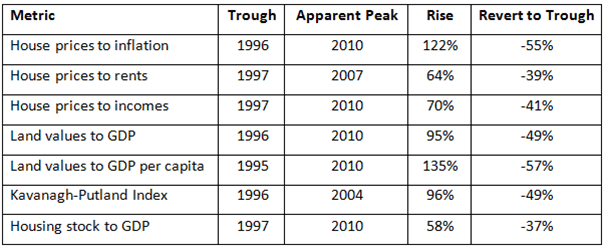Perhaps the only positive factor is the government’s relatively low position of gross debt to GDP. The fashionable idea often repeated these days is that rising public debt poses a risk to the economy has little substance in reality. Compared to the pre-WW2 era, the governments of today are a picture of fiscal responsibility and prudence, with the rise in taxation revenue helping to offset the need for using debt. In the event of a substantial and prolonged downturn in the economy, the federal and state governments are well-placed to debt-spend.

A better measure of government debt is net rather than gross debt, and even better is the net rather than gross interest repayment burden, expressed as a percentage of GDP. What matters for countries that have high levels of government debt is how great the net interest repayment burden is. This is what separates the US and Japan – countries with a relatively high level of government debt – with the basket-case PIIGS nations (Portugal, Italy, Ireland, Greece and Spain). Australia is currently situated in an excellent position, and even if the government debt to GDP ratio were to rise, this does not necessarily translate into higher net interest repayments if the RBA further cut interest rates from already historical lows and purchases government bonds.
Advertisement

Increases in the government debt to GDP ratio are typically due to two occurrences: World Wars (1914 – 1918 and 1939 – 1945) and responses to economic downturns caused by private debt-financed speculation: the 1890s, 1930s, mid-1970s, early 1980s, early 1990s and the GFC in 2008. The rise in the ratio before the 1890s was due to colonial government mass construction of public infrastructure. It is obvious to see which type of debt today presents an overwhelming macro risk to the economy. Government debt will inevitably rise to counter private debt-deleveraging but it is very unlikely that political parties will engage in the necessary and timely expansion needed to ward off the adverse effects of debt-deflation.

In conclusion, the data presented should provide more than enough evidence to suggest that Australia’s residential property market (specifically land market) is vastly overvalued, driven by debt-financed speculation and the relative non-taxation of land rent. While land bubbles have been a continual feature of the Australian economy, what separates this cycle is the relative enormity of the boom in both land values and private debt. A smaller private debt to GDP ratio during the 1880s and 1920s was enough to produce two devastating depressions, including a number of recessions during the mid-1970s, early 1980s and early 1990s.
The question is often asked why housing prices are so high. Instead, the real question is to ask why prices are so low. The banking and financial system is ready to lend absurd amounts of debt to the willing army of “greater fools,” and has constructed an elaborate chain from mortgage brokers’ offices through to the business development managers (BDMs) at the banks in order to commit extensive fraud by manipulating loan application forms. This is the “six degrees of separation” Denise Brailey has uncovered. Consequently, the only determinant that prevents the banks from lending more credit is debtors’ ability to finance repayments out of current income. Only when it becomes difficult to finance repayments will the housing and land markets finally capitulate.
It is often claimed “this time is different.” It certainly is, but not for the reasons usually given: Australia has not experienced a land bubble of this magnitude in its history. 70% of adults own property, solvency of the FIRE sector is dependent upon ever-increasing capital values and the governments’ addiction to housing-related tax revenue and votes, it is none too surprising bubble deniers have been out in full force, asserting housing prices are based upon fundamental valuations. Also unsurprising is that all bubble deniers have conflicts of interest, and in an age of the secular equivalent of religious fanaticism and greed, facts and history are conveniently dispensed down the memory hole.
Advertisement
The only option left to policymakers is to continually kick the can down the road, hoping the bust does not occur on their watch. The result, as seen with the Rudd government’s additional First Home Owner’s Boost, was precisely that. This intervention restarted the debt machine, re-inflating housing and land prices to a new, higher peak in 2010. The overarching private debt bubble, which began in 1964, will likely come to an end once and for all when the government runs out of fuel to throw on the fire.
Discuss in our Forums
See what other readers are saying about this article!
Click here to read & post comments.
4 posts so far.